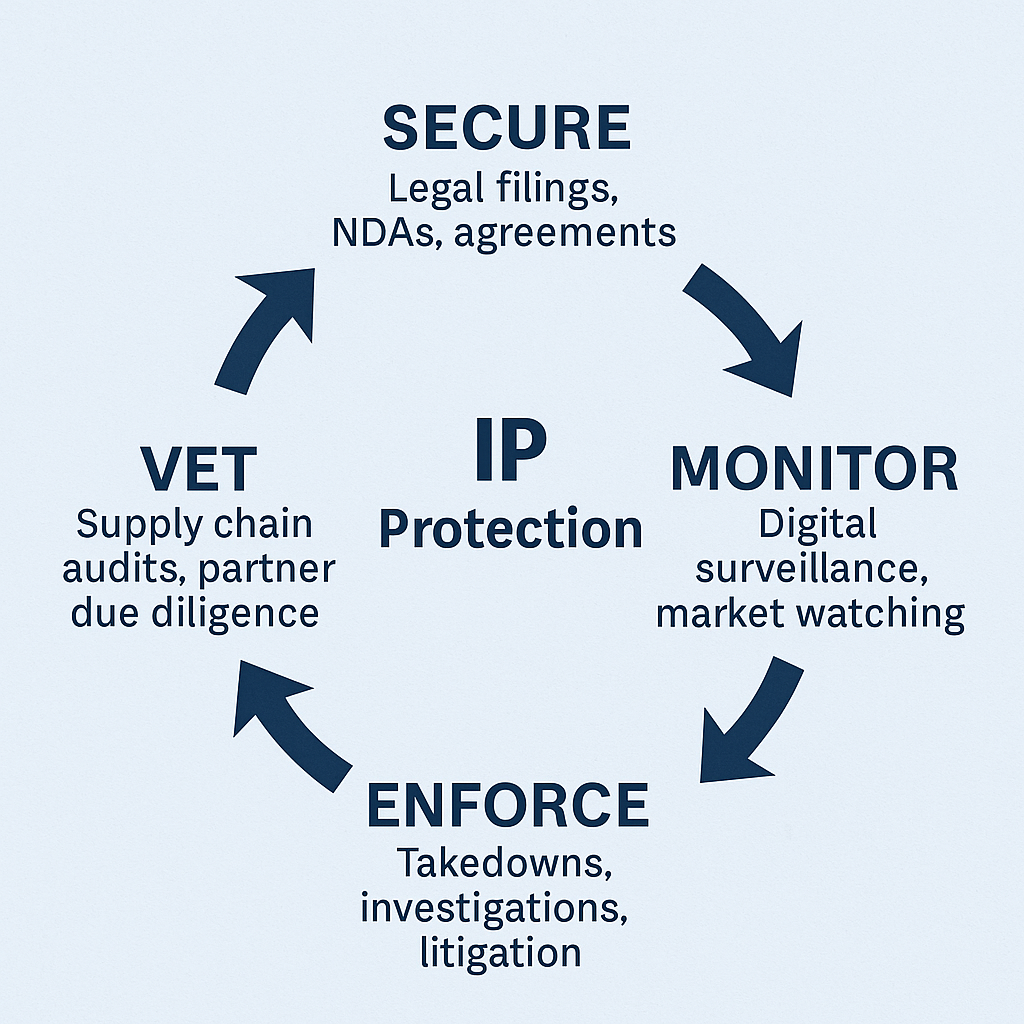In today’s hyperconnected world, your most valuable asset may not be what’s in your warehouse—it’s what’s in your head (or on your hard drive). Intellectual property (IP) is the fuel behind innovation, competitive advantage, and company valuation. But as global markets expand, so does the threat landscape. From patent pirates in overseas factories to deepfake brand impersonators online, IP protection is no longer just about filing paperwork—it’s about proactive strategy and intelligent surveillance.
At F3 Investigations, we’ve helped companies—from tech startups to multinational firms—protect their ideas, trade secrets, and reputations across borders. Here’s how we approach the challenge.
The Global IP Threat Landscape

Strategy 1: Secure Your Legal Foundations Early
First, protect your IP where it matters. That means registering patents, trademarks, and copyrights not only in your home country, but in key markets and manufacturing hubs abroad. The U.S. Patent and Trademark Office offers options like the Madrid Protocol to streamline trademark registration across 130+ countries [3]. For businesses relying on proprietary software or formulations, well-drafted nondisclosure and non-compete agreements—with enforceability in foreign courts considered—are a must.
Strategy 2: Monitor for Misuse—Online and Off
We don’t just file paperwork—we actively watch the world for IP misuse. Our teams conduct proactive monitoring on e-commerce platforms, international trade databases, dark web marketplaces, and even source code repositories. We’ve traced cloned product designs on overseas dropshipping sites and uncovered unauthorized brand use buried in influencer content campaigns. When something smells off, we dig in fast—and discreetly.
Strategy 3: Vet Your Partners (Yes, All of Them)
Many IP theft cases originate from inside relationships. Whether it’s a joint venture, third-party manufacturer, or remote contractor, thorough due diligence is your first defense. We perform comprehensive background checks, business intelligence reviews, and supply chain audits to identify hidden affiliations, shell companies, or past IP disputes that might not show up in public records [4].
Strategy 4: Use Technology to Your Advantage
Modern threats require modern countermeasures. We use image recognition to detect logo misuse, blockchain analysis to uncover unauthorized use of IP in tokenized form, and AI-driven linguistics tools to flag suspicious activity in forums and internal chats. These aren’t gimmicks—they’re necessary layers in a world where digital replicas can spread faster than legal notices.
Common IP Theft Red Flags
Is Your IP at Risk? Watch for These Red Flags:
- A sudden dip in sales in a specific region with no clear cause.
- Your designs or product images popping up on unauthorized sites like Alibaba or Temu.
- A former employee launching a near-identical product under a new brand.
- Bad online reviews referencing poor quality on items you don’t actually sell.
- Support tickets or refund requests for products you’ve never made or distributed.
If any of these sound familiar, it might be time to investigate.
The first smoking gun to check out when looking for patent infringement is to take a look at your patent’s Forward Citations. A Forward Citation is the citing of your patent as Prior Art by a patent filed after your patent. The more Forward Citations as patent has, the greater the chances it has been infringed, and probably by one or more of the companies that filed a patent that cited yours as Prior Art.
Alec Schibanoff, Vice President of IPOfferings, a leading patent firm
Case Study: Defending a Fashion Brand from Overseas Counterfeiting
One client, a U.S.-based luxury fashion brand, noticed suspiciously similar products appearing on overseas marketplaces. Within 48 hours, we identified the source: a rogue supplier from a terminated vendor relationship. Using digital forensics and open-source intelligence, we traced the listings back to a shell company with ties to multiple counterfeit operations in Southeast Asia. Our evidence helped their legal team win an international takedown order and recoup damages through civil litigation [5].
Why IP Protection Isn’t One-and-Done
Intellectual property protection is not a “set it and forget it” task. It’s a continuous process of defending your ideas in a shifting global landscape. We blend old-school investigative tactics with digital surveillance, legal know-how, and global reach to help our clients stay a step ahead of IP theft—no matter where the threat originates.
If you’re expanding into new markets, launching a product, or suspect your IP has already been compromised, reach out to us for a confidential strategy session. We’ll help you lock down what matters most—before someone else makes it theirs.
Reference List
- U.S. Chamber of Commerce Global Innovation Policy Center. The Economic Impact of Counterfeiting and Piracy. 2024.
- Cybersecurity Ventures. 2024 Cybercrime Report. 2024.
- World Intellectual Property Organization. Madrid System for the International Registration of Marks. 2024.
- U.S. Department of Commerce. Intellectual Property Protection: Practical Tips for Global Markets. 2023.
- F3 Investigations (Internal Case File). “Fashion Brand Counterfeiting Operation – Southeast Asia Takedown.” 2024.